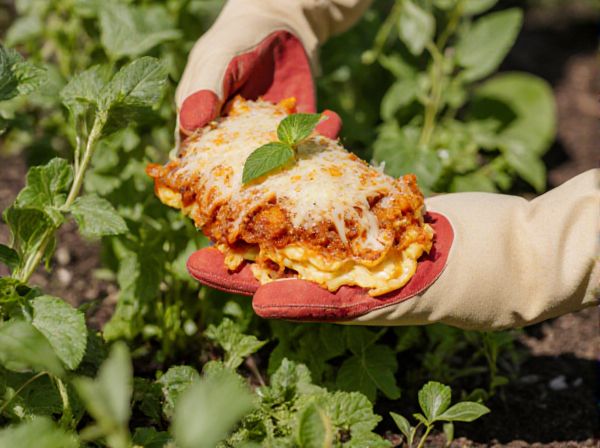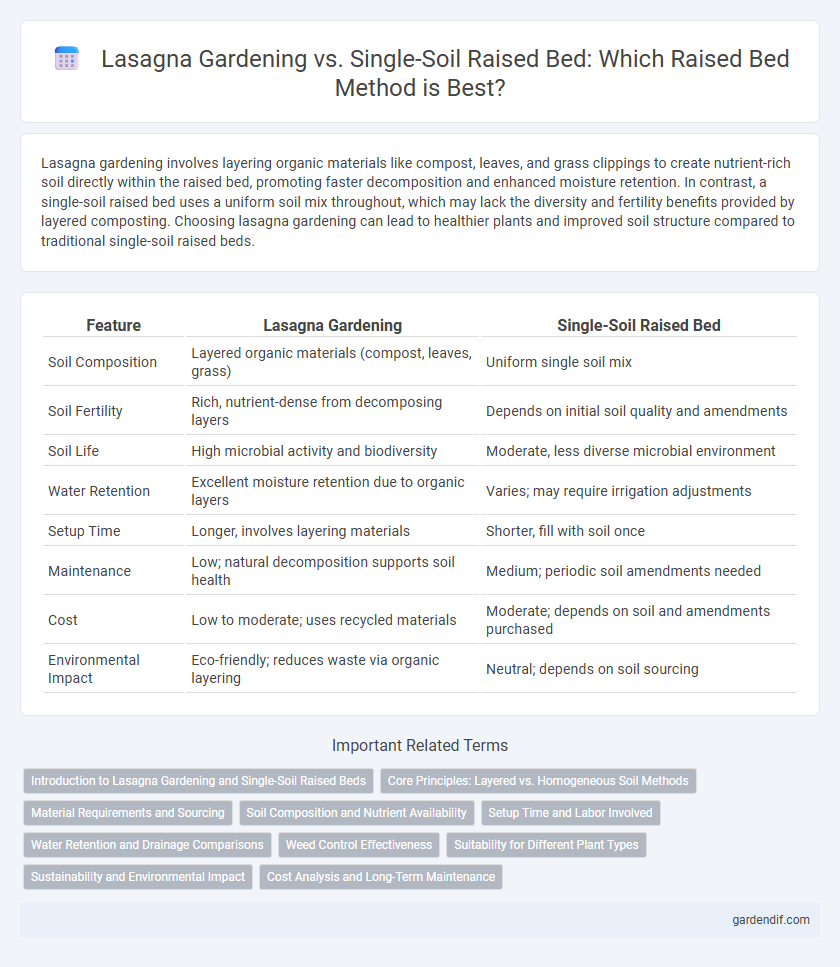
lasagna gardening vs single-soil raised bed Illustration
Lasagna gardening involves layering organic materials like compost, leaves, and grass clippings to create nutrient-rich soil directly within the raised bed, promoting faster decomposition and enhanced moisture retention. In contrast, a single-soil raised bed uses a uniform soil mix throughout, which may lack the diversity and fertility benefits provided by layered composting. Choosing lasagna gardening can lead to healthier plants and improved soil structure compared to traditional single-soil raised beds.
Table of Comparison
| Feature | Lasagna Gardening | Single-Soil Raised Bed |
|---|---|---|
| Soil Composition | Layered organic materials (compost, leaves, grass) | Uniform single soil mix |
| Soil Fertility | Rich, nutrient-dense from decomposing layers | Depends on initial soil quality and amendments |
| Soil Life | High microbial activity and biodiversity | Moderate, less diverse microbial environment |
| Water Retention | Excellent moisture retention due to organic layers | Varies; may require irrigation adjustments |
| Setup Time | Longer, involves layering materials | Shorter, fill with soil once |
| Maintenance | Low; natural decomposition supports soil health | Medium; periodic soil amendments needed |
| Cost | Low to moderate; uses recycled materials | Moderate; depends on soil and amendments purchased |
| Environmental Impact | Eco-friendly; reduces waste via organic layering | Neutral; depends on soil sourcing |
Introduction to Lasagna Gardening and Single-Soil Raised Beds
Lasagna gardening involves layering organic materials such as compost, shredded leaves, and grass clippings to create nutrient-rich soil directly in the raised bed, promoting healthy plant growth without the need for tilling. Single-soil raised beds use a uniform soil mix, often composed of topsoil, compost, and sand, providing consistent texture and drainage for root development. Both methods improve soil quality and drainage but lasagna gardening offers continuous nutrient replenishment through decomposition, while single-soil beds rely on periodic soil amendments.
Core Principles: Layered vs. Homogeneous Soil Methods
Lasagna gardening employs a layered approach by stacking organic materials such as compost, mulch, and kitchen scraps to build nutrient-rich soil, fostering natural decomposition and promoting soil fertility. In contrast, single-soil raised beds use a homogeneous soil mixture, often a blend of topsoil, compost, and vermiculite, providing uniform texture and drainage for consistent root growth. The layered method enhances microbial diversity and aeration, while the homogeneous soil ensures steady moisture retention and easier planting.
Material Requirements and Sourcing
Lasagna gardening requires layers of organic materials such as compost, shredded leaves, grass clippings, and kitchen scraps, which are often sourced from local gardens, households, or landscaping waste, promoting sustainability and cost-effectiveness. In contrast, single-soil raised beds primarily use high-quality topsoil or a soil mix, which may need to be purchased from nurseries or garden centers, potentially increasing material costs and reliance on external suppliers. The layered approach of lasagna gardening enhances soil fertility over time, while single-soil beds require more frequent soil amendments to maintain nutrient levels.
Soil Composition and Nutrient Availability
Lasagna gardening incorporates multiple organic layers such as compost, grass clippings, and kitchen scraps, creating a rich, well-aerated soil with high nutrient availability compared to a single-soil raised bed, which relies primarily on one soil medium. The diverse organic matter in lasagna gardening promotes microbial activity and nutrient cycling, enhancing soil fertility over time. In contrast, single-soil raised beds may require more frequent fertilization and soil amendments to maintain optimal nutrient levels for plant growth.
Setup Time and Labor Involved
Lasagna gardening requires more initial setup time and labor due to layering organic materials such as compost, leaves, and grass clippings, which need to decompose before planting. Single-soil raised beds involve simpler preparation by filling the bed directly with pre-mixed soil, significantly reducing effort and time. The decomposition process in lasagna gardening also demands periodic maintenance to maintain soil quality, whereas single-soil beds are usually ready for immediate planting.
Water Retention and Drainage Comparisons
Lasagna gardening excels in water retention due to its layered organic materials that hold moisture effectively, reducing the frequency of watering. In contrast, single-soil raised beds typically offer better drainage since they are often filled with a sandy or loamy mix that prevents waterlogging. While lasagna beds improve soil moisture consistency, single-soil beds minimize the risk of root rot by allowing excess water to escape more efficiently.
Weed Control Effectiveness
Lasagna gardening excels in weed control effectiveness due to its multi-layered approach that suppresses weed growth by blocking sunlight and enriching soil organic matter. Single-soil raised beds, while easier to prepare, often require more frequent weeding since they lack the natural weed barrier provided by decomposing layers. Incorporating organic materials in lasagna gardening significantly reduces weed intrusion compared to traditional raised bed methods.
Suitability for Different Plant Types
Lasagna gardening excels for growing diverse plant types by layering organic materials that improve soil fertility, moisture retention, and structure, making it ideal for nutrient-demanding vegetables like tomatoes and peppers. Single-soil raised beds offer a more uniform growing medium suited for root vegetables such as carrots and potatoes, where consistent soil texture and drainage are critical. Choosing between the two depends on plant requirements: lasagna beds optimize growth for heavy feeders and mixed crops, while single-soil beds benefit plants needing stable, well-drained soil conditions.
Sustainability and Environmental Impact
Lasagna gardening enhances sustainability by layering organic materials that decompose naturally, enriching soil fertility without synthetic inputs, reducing waste through composting kitchen scraps and yard debris. Single-soil raised beds often require external soil mixes, which can involve peat or non-renewable resources that impact ecosystems negatively. The lasagna method promotes water retention and biodiversity, minimizing the need for chemical fertilizers and irrigation, thereby reducing the overall environmental footprint of raised bed gardening.
Cost Analysis and Long-Term Maintenance
Lasagna gardening typically incurs lower initial costs by utilizing layered organic waste materials instead of purchasing premium soil mixes for single-soil raised beds. Long-term maintenance in lasagna gardening involves nutrient replenishment through ongoing organic matter addition, which enhances soil fertility naturally and reduces fertilizer expenses over time. In contrast, single-soil raised beds demand periodic soil amendments and potential re-soiling, resulting in higher maintenance costs and less sustainable nutrient cycling.
lasagna gardening vs single-soil raised bed Infographic

 gardendif.com
gardendif.com